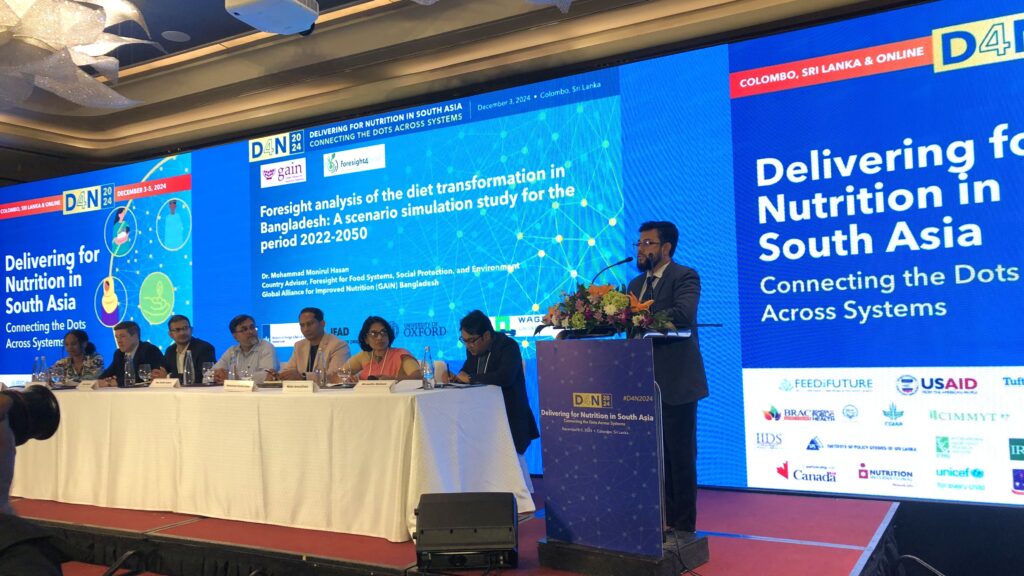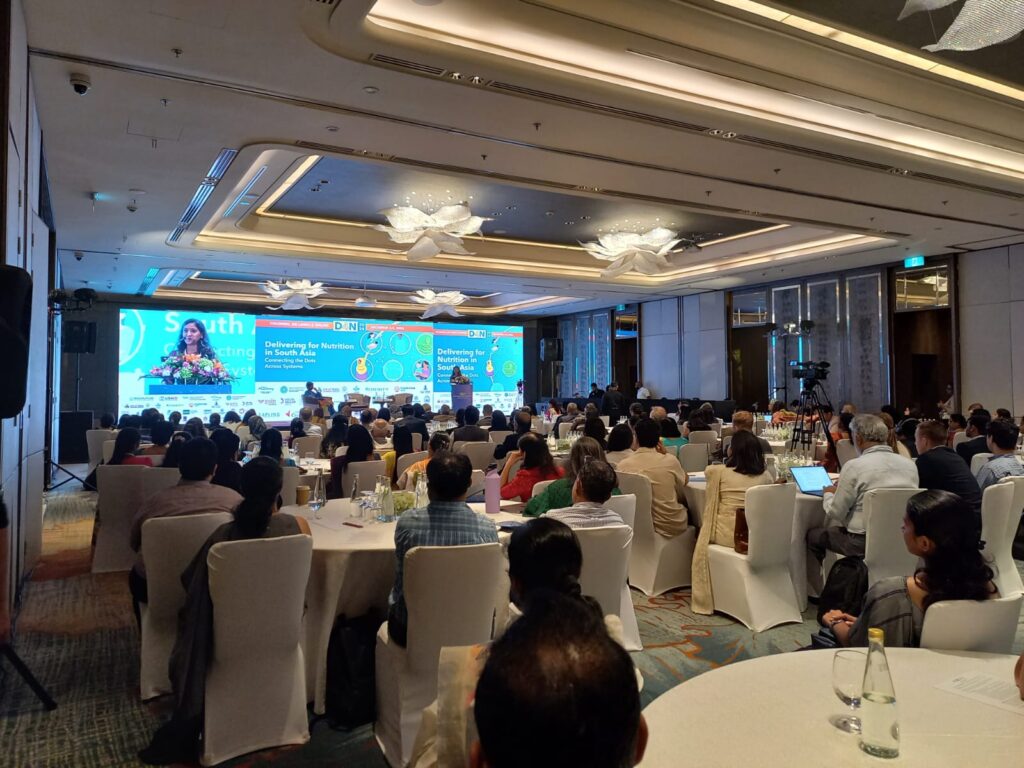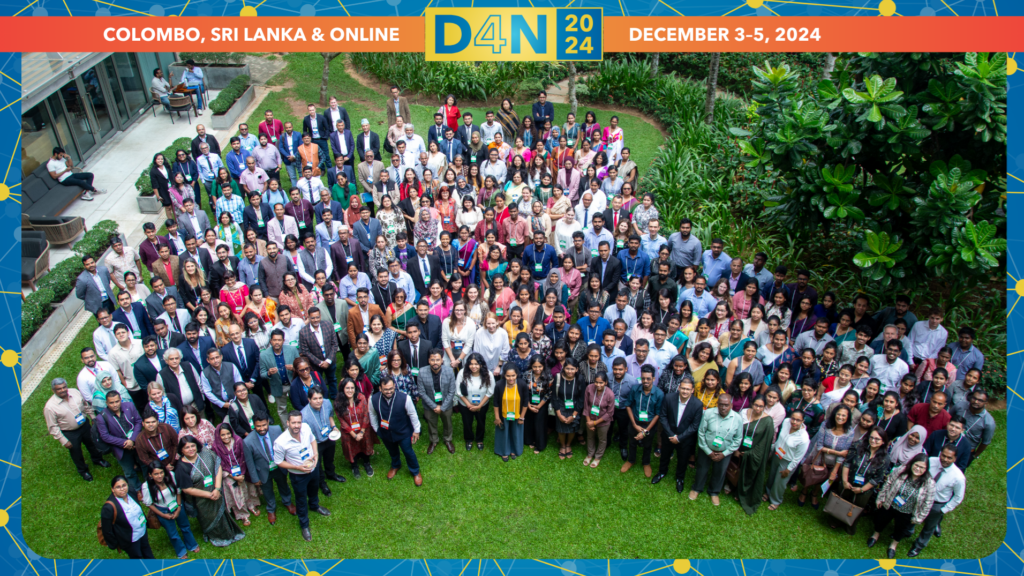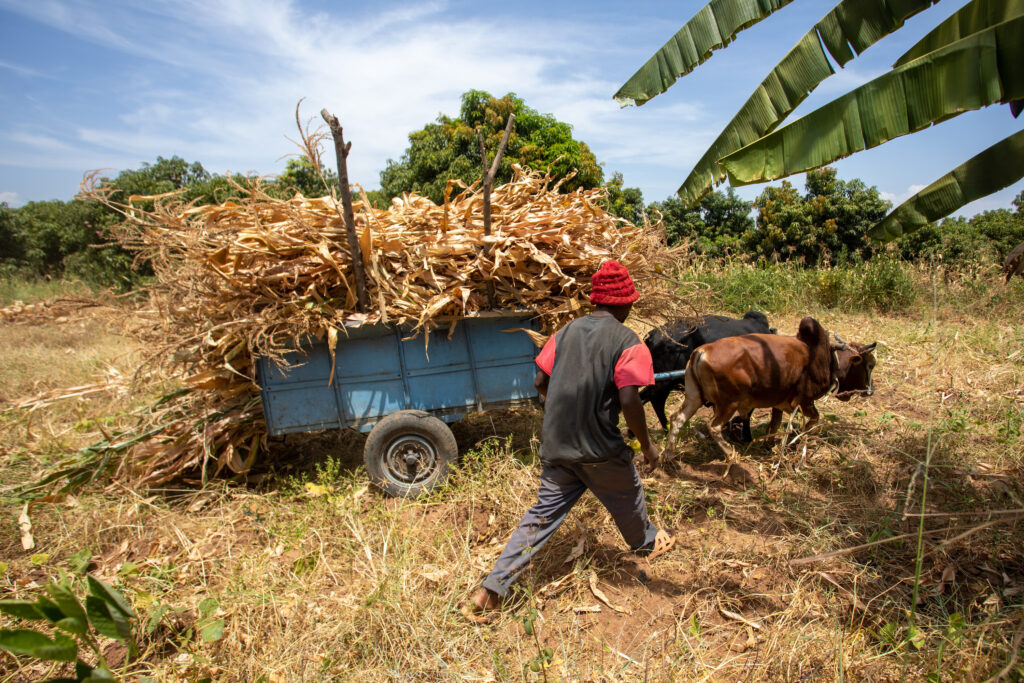By Mohammad Monirul Hasan, Foresight4Food FoSTr Bangladesh Facilitator
In December 2024, I had the privilege to participate in the Delivering for Nutrition (D4N) in South Asia: Connecting the Dots Across Systems conference, held in Colombo, Sri Lanka. This significant event, hosted by IFPRI in collaboration with CGIAR and regional partners, convened experts and stakeholders to tackle South Asia’s enduring nutrition challenges. Given the region’s double burden of malnutrition—persistent undernutrition alongside a surge in obesity and non-communicable diseases—the discussions underscored the urgent need for integrated, forward-thinking strategies to ensure sustainable nutrition security. Here are some of my insights from the conference.
Harnessing Foresight Research for Food Systems Transformation

At the conference, I had the privilege of presenting our research on foresight-driven food systems transformation and the Diet Scenario 2050 for Bangladesh, a project supported by Oxford University, Wageningen University & Research, and GAIN. Our research employs foresight methodologies to anticipate future food system trajectories and design actionable pathways toward nutrition security. By leveraging scenario-building and participatory modeling, we explore how household decision-making, agricultural innovations, and policy interventions can collectively enhance food system resilience.
The Crucial Role of Foresight in Addressing Nutrition Challenges
The conference highlighted foresight methodologies as crucial tools for anticipating emerging trends and informing adaptive policy responses. In dialogues with IFPRI’s Foresight Team and CGIAR’s Food Systems Hub representatives, we explored critical gaps in food systems research and discussed collaborative approaches to align foresight insights with policy and investment strategies. Our discussions identified opportunities for:
- Evidence-Based Policymaking: Using foresight outputs to inform national and regional policy frameworks.
- Scenario Analysis: Modeling climate impacts, dietary shifts, and technological advancements to guide policy development.
- Cross-Sector Collaboration: Engaging agriculture, health, and education sectors to build integrated solutions.
Regional Collaboration and Investment for Food Systems Transformation
The conference provided a unique platform for fostering regional partnerships. Through interactions with policymakers, development agencies, and investors, we identified actionable steps to promote cross-border foresight initiatives that can enhance food systems resilience across South Asia. Key takeaways included:
- Shared Learning Platforms: Promoting knowledge exchange across countries to address common nutrition challenges.
- Regional Investment Frameworks: Encouraging collaborative investments in sustainable food systems and nutrition programs.
- Public-Private Partnerships: Mobilizing resources from diverse sectors to scale impactful innovations.



Insights for Policy and Practice: Moving Forward with Foresight
Key lessons from the conference emphasized the transformative power of foresight for achieving sustainable nutrition outcomes:
- Anticipatory Governance: Foresight can help policymakers proactively address emerging risks and opportunities.
- Systems Thinking: Integrating health, agriculture, and socio-economic perspectives is crucial for holistic solutions.
- Multi-Sectoral Collaboration: Effective partnerships between governments, academia, and the private sector are essential for impactful interventions.
- Investment Alignment: Foresight insights can guide investors to support high-impact initiatives that promote nutrition security.
Conclusion: Shaping the Future of Food Systems in South Asia
This conference reinforced the value of foresight methodologies in driving evidence-based decisions and fostering regional cooperation. It provided a platform to showcase Bangladesh’s commitment to forward-looking strategies and collaborative approaches that address the interlinked challenges of nutrition, climate resilience, and food security. Building on these insights, I look forward to advancing partnerships and implementing foresight-driven initiatives that contribute to sustainable food systems transformation across South Asia.
By Zoë Barois
To support the lasting and valuable development of any multi-stakeholder network, it is important to explore its perceived values and positioning from the perspective of various key and transdisciplinary stakeholders. In line with this concept, five members from the Advanced Masters International Development (AMID) Programme at Radboud University including Emma John, Guusje Dijkstra, Meg van Grinsven, Nadia Rinaldi, and Zoë Barois, collaborated to explore stakeholder perceptions on the perceived values of the Foresight4Food Initiative and the risks it faces when participating in multi-stakeholder networks.
The team conducted seven interviews with foresight experts and practitioners from private, governmental, research, and multilateral organizations, in addition to experts in multi-stakeholder partnerships. Some interesting findings came up in the interviews that led to the development of several guidelines.
Perceived Values of Foresight4Food
The interview participants appreciated that the Foresight4Food Initiative connects stakeholders to (new) players in the field and enables their work to be critically examined by specialists. Being able to harness expertise in the field of foresight and apply this to food system transformation was highlighted to facilitate a deeper understanding of the suitability of foresight tools in diverse contexts.
Additionally, the interviewees highlighted Foresight4Food’s unique value is that it is one of the few initiatives working on food system transformation on a global level, as opposed to most initiatives that focus on national or regional scopes.
Foresight4Food’s deliberate focus on the processes (rather than the product) of forecasting future scenarios was emphasized as a value in itself as it is a strategic tool for food systems transformation.

An interviewee highlighted the benefit of Foresight4Food’s open-access resource platform and their ability to provide a neutral meeting space that facilitates cross-learning and a deeper understanding of foresight and food system trends among stakeholders.
“…we see it [Foresight4Food] as a great forum to exchange learning, for example, we just took the exploratory scenario planning process and customized it for use with multi-stakeholder partnerships… this is a tool that already existed that we kind of adapted and would love to share how that works so other people can pick that up…’’ – Foresight Practitioner
Risks Faced by Foresight4Food: Positionality & Durability
During the multi-stakeholder interviews, several thematic risks emerged relating to Foresight4Food’s durability and positionality within the active foresight landscape.
The long-term thinking required to envision the outcomes of Foresight4Food poses challenges in terms of sustainability as this makes it difficult for organizations to invest in the initiative due to investors’ often short-term vision and the need to “show results as quickly as possible” – Foresight Expert — a common challenge faced by many organizations in the development sector.
In relation to Foresight4Food’s positionality, the initiative faces the risk of being duplicated by similar organizations and, consequently, being “squeezed out by the big players if they feel that we are an irritant on the side of what they consider to be their patch” – Foresight Expert
Lastly, Foresight4Food faces the risk of not being “democratised enough and sublevel enough” to truly get involved with the root causes of the food system issues. This stems from the current engagement of true experts in the field and thus emerges as an ‘’elite network’’ initiated by two high-profile universities. This lack of inclusivity is further emphasized by interviewees “not capable of being inclusive we are going to fail giving to those that actually can benefit the most from our work” – Foresight expert
Subsequently, one of the main challenges of F4F is effective outreach and engagement with stakeholders.
Proposed Guidelines
Taking into account Foresight4Food’s vision and the thematic risks which emerged from the multi-stakeholder interviews, several guidelines were generated aiming to support the sustainable and valuable development of Foresight4Food’s multi-stakeholder network.
1. Foresight4Food’s Positionality
Enhancing F4F’s positionality is crucial for the initiative to find its niche. Therefore, the following guidelines are suggested:
- Conducting a needs assessment of the current network members can enable F4F to identify and prioritize their needs.
- The outcomes from the needs assessment can provide an informed direction to perform a visioning exercise. Matchmaking between desired visions and the long-term forecast
- Continuously update the existing mapping of foresight initiatives across the food system. This can be used to perform a competitor analysis to assess the existing gaps in the foresight and food systems field and formulate associated research questions.
- Facilitating smaller partnerships amongst F4Fs members, was highly valued by an interviewee thus F4F could link initiatives conducting complementary activities identified in their foresight initiative mapping, further enhancing their value.
2. Sustainability: Foresight for Foresight4Food
To ensure Foresight4Food’s sustainability and longevity, Foresight4Food must become more attractive to investors:
- ‘Foresight for Foresight4Food’: generating potential future scenarios for F4F to clarify what outcomes and impact F4F envisions in its short- and mid-term futures.
- This can be further enhanced and formulated into concrete goals by a Monitoring, Evaluation & Learning (MEL) expert, who can contextualize F4F’s Theory of Change towards each of the five FoSTr countries, providing concrete outcomes, which are actualized for funders to grasp and support.
- Develop a funding strategy to generate a diversified funding portfolio to ensure financial flow from a variety of sources.
- Attract funding from the private sector and from philanthropy as they are harboring the most financial power within the field.
- Consider transferring core operations and leadership to stakeholders in target operational areas (i.e., the FoSTr countries). This would require creating an inclusive roadmap for phasing-out and phasing-in new or alternative network partners.
3. Inclusivity & representativeness
To make F4F more inclusive, the following recommendations are provided:
- Stakeholder Characteristics and Roles Matrix to map to identify stakeholders who are not yet on board or have a low influence within the network.
- Introduce a ‘second circle’ around the steering committee to include a diversified set of stakeholders in the decision-making processes. This second circle could include farmers, youth representatives, and/ or representatives from the five FoSTr programme focus countries.
- Generate a sense of ownership amongst second circle members through co-creation
To conclude
Foresight4Food Initiative is striving to develop and strengthen its network among foresight practitioners and different stakeholders. However, it gets challenging for any organization to work in a multi-stakeholder environment. Therefore, an exploratory look at the perceived values and positionality becomes imperative.
Foresight4Food, under its FoSTr programme is working in five countries across Africa, Asia, and the Middle East, conducting foresight orientation, stocktaking, capacity building, and exploring ways to transform the country’s food systems. Thus, making it the right time to explore sustainable positioning from a stakeholder’s perspective.